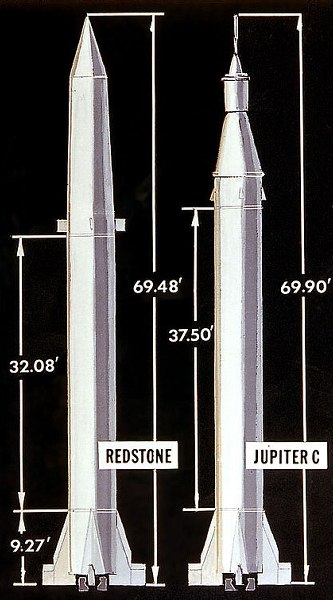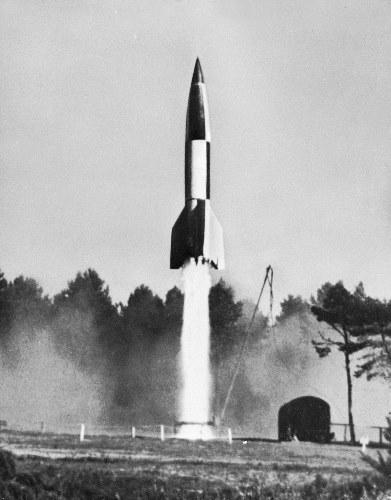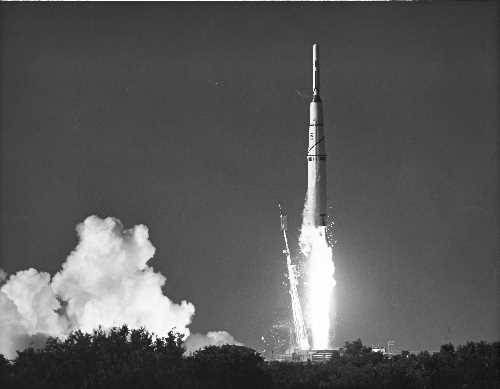
I'm still waiting for my January F&SF to show up, so here's another topical scientific post. Just call me Willy Ley's poor cousin.
The space stories in today's newspapers are filled with a mixture of alphabet soup and Roman mythology. Keeping track of what's what can be a headache. For instance, there has been a lot of confusion regarding the naming of the rocket that launched Explorer I (and III and IV, and tried to launch II and V). Some accounts called it a Jupiter-C. Others have since called it a Juno I. Which is correct? Is there a Jupiter missile somewhere in there? Does it even matter?
Let me clear things up. The answer shines an interesting spotlight into the politics of naming and the jockeying for position being done by this country's armed services.
Back in 1953, Von Braun and his Alabama team of German expatriates finished the first significant rocketry development since the V2 (which they had also built). It was the Redstone Medium Range Ballistic Missile (MRBM) with a range of more than a hundred miles. Von Braun knew he had a vehicle that was powerful enough to send something into orbit, and he lobbied heavily for his "Project Orbiter" so that he, and the Army, could launch the first artificial satellite. He lost that fight to the Navy, who started work on the Vanguard, based in turn on the Viking sounding rockets, which were based on the V2.
Nevertheless, Von Braun did win the contract to build the longer-ranged successor to the Redstone, the Jupiter Intermediate Ranged Ballistic Missile (IRBM). This let Von Braun keep Project Orbiter alive, at least under wraps. The first step toward turning the Redstone into a satellite booster was a series of test launches with Jupiter IRBM components on board. He called the resulting machine "Jupiter-A," even though at its heart, it was really a Redstone. This helped ensure launch pad availability, since the Jupiter was a higher-priority program.
Then he added 11 miniaturized solid-rocket boosters called Sergeants (descendants of the WAC Corporal rocket, of course) as a second stage and one more as a third stage. This new booster was used as a sounding rocket, probing the outer reaches of the atmosphere in short suborbital flights, and was called the "Jupiter-C." I don't know if there were ever plans for a "Jupiter-B."
Once Sputnik was launched, America was hard-pressed to make a quick response. Von Braun trotted out the Jupiter-C, all ready to launch a payload. It wasn't quite enough to get Explorer I into orbit, however, so another mini-Sergeant was attached to the satellite and placed on top of the Jupiter-C third stage. This technically made the Jupiter-C a four-stage rocket, even though one could argue that the fourth stage was really part of the payload.
It was important that there be little connection between the military space programs and the civilian space programs, at least in the press. That's why Vanguard was given the nod for the first satellite launch. While it was developed by the Navy, it was run under the auspices of the civilian National Research Laboratory. Jupiter-C was renamed "Juno I" to distance the rocket from its military origins.
It was not a very successful move. Contemporary newspapers universally referred to the rocket as the Jupiter-C (which, of course, it was). The name "Juno I" is only now common in retrospective use, as its last flight was on October 23. It is a useful distinction, however, as Von Braun has taken the 2nd, 3rd and "4th" stages from the Juno I and affixed them to a true Jupiter IRBM, thus creating the "Juno II." This new vehicle should have about the same lifting capacity as the Air Force's Thor-Able, maybe a little less. It will launch Pioneer III next week. Note: Pioneer III has nothing to do with Pioneers 0-II save that they have the same destination, the moon.
All clear?
(Confused? Click here for an explanation as to what's really going on)
This entry was originally posted at Dreamwidth, where it has comments. Please comment here or there.















